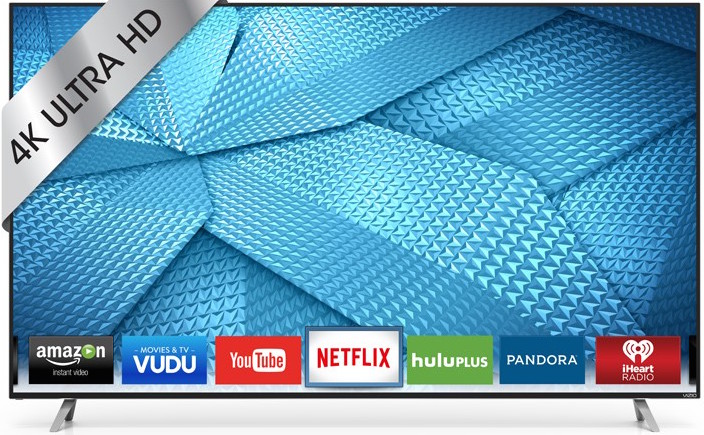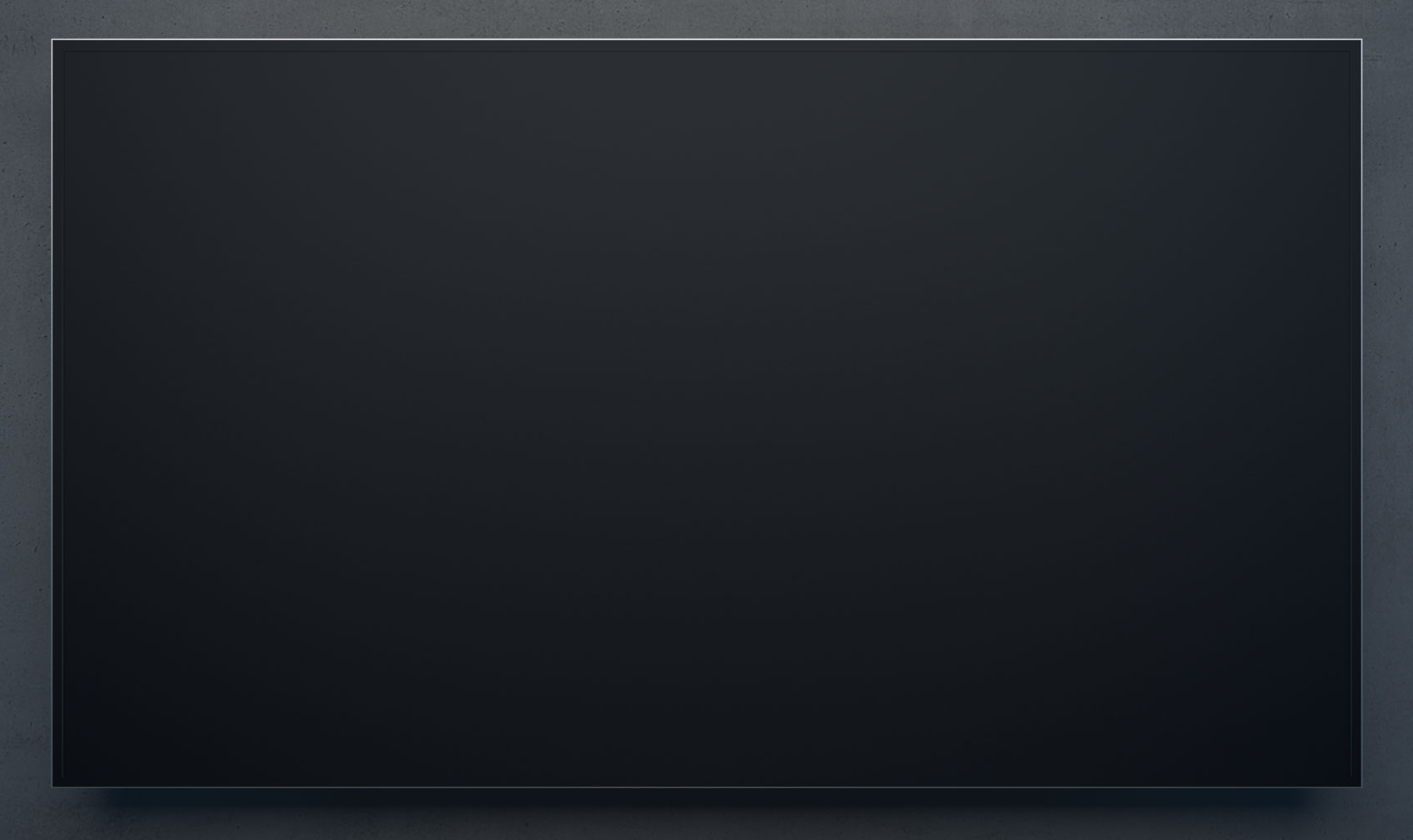Vizio Introduces M-Series 4K TVs Starting At $599; Reference Lineup Includes Dolby Vision
The cost of 4K TVs is still expensive, as you'll have to fork over at least $1,000 for what seems to be the next standard for displays. However, Vizio is changing the game a bit with the launch of its new M-Series Ultra HD Full Array LED Smart TVs, which cost as little as $599.99.
The company is offering a wide array of 4K TVs in the M-series, ranging from a 43-inch display ($599.99) to its high-end 80-inch TV (which will cost you a staggering $3,999.99). The prices for the other TVs in the M-series are listed in the chart below.
| M-Series 43-inch Ultra HD Full Array LED Smart TV | $599.99 |
| M-Series 49-inch Ultra HD Full Array LED Smart TV | $769.99 |
| M-Series 50-inch Ultra HD Full Array LED Smart TV | $799.99 |
| M-Series 55-inch Ultra HD Full Array LED Smart TV | $999.99 |
| M-Series 60-inch Ultra HD Full Array LED Smart TV | $1499.99 |
| M-Series 65-inch Ultra HD Full Array LED Smart TV | $1699.99 |
| M-Series 70-inch Ultra HD Full Array LED Smart TV | $2199.99 |
| M-Series 75-inch Ultra HD Full Array LED Smart TV | $2999.99 |
| M-Series 80-inch Ultra HD Full Array LED Smart TV | $3999.99 |
Vizio claimed to provide the best 4K experience yet with a slew of features such as Full Array LED backlighting, which provides a better distribution of light compared to most of today's HDTVs, which are lit by LEDs from opposite edges of the TV. The company also touted its Clear Action technology, which allows for fast refresh rates in the range of 120-240 Hz.
Underneath is what Vizio likes to call a "V6 six-core processor," which is actually a quad-core GPU and a dual-core CPU. It also has the ability to upscale HD content to UHD with the company's Spatial Scaling Engine.
For online connectivity, the M-Series comes with dual-band 802.11 a/c Wi-Fi. Vizio also has its own smart TV platform called Vizio Internet Apps, which provides for streaming services such as Netflix, Hulu Plus and Amazon Instant Video. As far as 4K content is concerned among those three brands, only Netflix and Amazon have shows running at 4K resolution. The M-Series has five HDMI ports: component, composite, tuner, Ethernet and a USB port. You can plug in an external USB device to display photos, videos and music stored on the drive.
The M-Series seems to be catered to the mainstream crowd looking to get into 4K, but Vizio is also working on another set of 4K TVs for the cinephile called the Reference Series Ultra HD Full-Array LED Smart TVs. The big difference between the M-Series and Reference Series is the inclusion of Dolby Vision in the latter, a new technology from the well-known audio company. At its foundation, Dolby Vision claims to be the perfect complement to 4K, by providing a wider color gamut, high dynamic range and brighter images.
The Reference series comes in 65- and 120-inch models, and more details including price and specs are coming soon. Vizio said that there will be content featuring Dolby Vision through Warner Bros. and VUDU, Walmart's video service.
Get Tom's Hardware's best news and in-depth reviews, straight to your inbox.
With the announcement of these two lineups, Vizio is showing the market that it can provide a wide array of 4K TVs starting at an affordable price, and that it's already thinking about the next big thing in display technology.
Follow Rexly Peñaflorida II @Heirdeux. Follow us @tomshardware, on Facebook and on Google+.
Rexly Peñaflorida is a freelance writer for Tom's Hardware covering topics such as computer hardware, video games, and general technology news.
-
SlitelyOff Must say, I didn't expect 4k to make that much of a difference, but I just picked up a 50" 4k Vizio 502-bu(?) and the picture is exquisite. I also own a 55" 820 series Sony 55". Makes me want to get a 65 or 70" for living room now...but I can wait. I am surprised to see how quickly 4k sets are coming down in price.Reply -
CaedenV I am really excited to see 4K displays coming down in price. I have not had a traditional 'TV' in the house for nearly 8 years now (we have PCs with what was once considered 'large' 28" monitors), but am really interested in picking up UHD (not 4K) displays for both of the house computers in the next year or two. In all likelihood it will just run as UHD for desktop and movies, and 1080p for anything graphically intensive for the next few years as GPUs play catchup, but a 45-55" UHD TV would make a rather excellent monitor.Reply
It will be curious to see if UHD displays will be easier to dumb down into a 'dumb display' mode rather than constantly trying to alter the input... also curious to see if win10 will play nicer with displays like TVs with more contrast than traditional monitors.
Oh... and to the author: It is Wireless ac, or 802.11ac, not a/c. 802.11a is no longer used anywhere, and 802.11c was never really 'a thing' in the consumer space. -
Larry Litmanen I was in Best Buy the other day and saw (i think LG) OLED 4K TV, that was something else. Honestly it puts regular 4K to shame.Reply
Geez you have to give these companies some credit, they keep innovating. -
CaedenV ReplyMust say, I didn't expect 4k to make that much of a difference, but I just picked up a 50" 4k Vizio 502-bu(?) and the picture is exquisite. I also own a 55" 820 series Sony 55". Makes me want to get a 65 or 70" for living room now...but I can wait. I am surprised to see how quickly 4k sets are coming down in price.
Agreed. I thought that 4K/UHD was going to be the bread and butter maker for panel makers for the next 5-10 years, but the price is dropping so quickly that I don't see how they are going to keep their margins up for very long. When the first real products were introduced a mere 18 months ago a UHD display cost some $25,000, and now you can find some really nice displays in the $1-2,000 range, and decent budget panels well under $1,000. I thought I was not going to be able to afford one for a good 5 years after release, but now I am looking at picking up my first panel as soon as I finish being a full-time student and land a real job this fall. It is mind-blowing just how quickly UHD has caught on... I wonder just how much UHD BluRay discs are going to cost when they are released this fall. Will they be super expensive? Or will they drop in price just as quickly as the displays have?
-
mutatio I'm just excited that Vizio got rid of the God awful design of the logo tumor growing off the lower right hand side of the set. That was just plain stupid.Reply -
TeamColeINC 4K might just become the new standard faster than I thought, just last year Vizio's 1080p M-series cost just as much.Reply -
knowom ReplyI was in Best Buy the other day and saw (i think LG) OLED 4K TV, that was something else. Honestly it puts regular 4K to shame.
After like a decade of doing virtually nothing to innovate on top of being guilty of LCD price fixing yeah let's give them credit.
Geez you have to give these companies some credit, they keep innovating.
These should still be closer to $400's for a reasonable entry 4k 60Hz quality 40-45" display. It's say to say 4K being x4 1080p resolution should be reasonably cheaper to manufacturer than x4 separate 1080p displays so they should still come down in price a bit. I'm not jumping on the bandwagon just yet especially as GPU's need to play some catch up anyway in terms of relative performance at 4K. -
drmcstroks the reason theyre coming down in price so fast is because 8k tvs are already coming out :PReply -
ocilfa "Rtings" did a review on these sets a little while ago. It does have great performance in many regards, and does indeed have hdmi 2.0. However, it does not have full 4:4:4 chroma support, and it does not handle motion all that well(Motion trails as they call it).Reply

